2015 MERCEDES-BENZ GLE COUPE torque
[x] Cancel search: torquePage 23 of 393
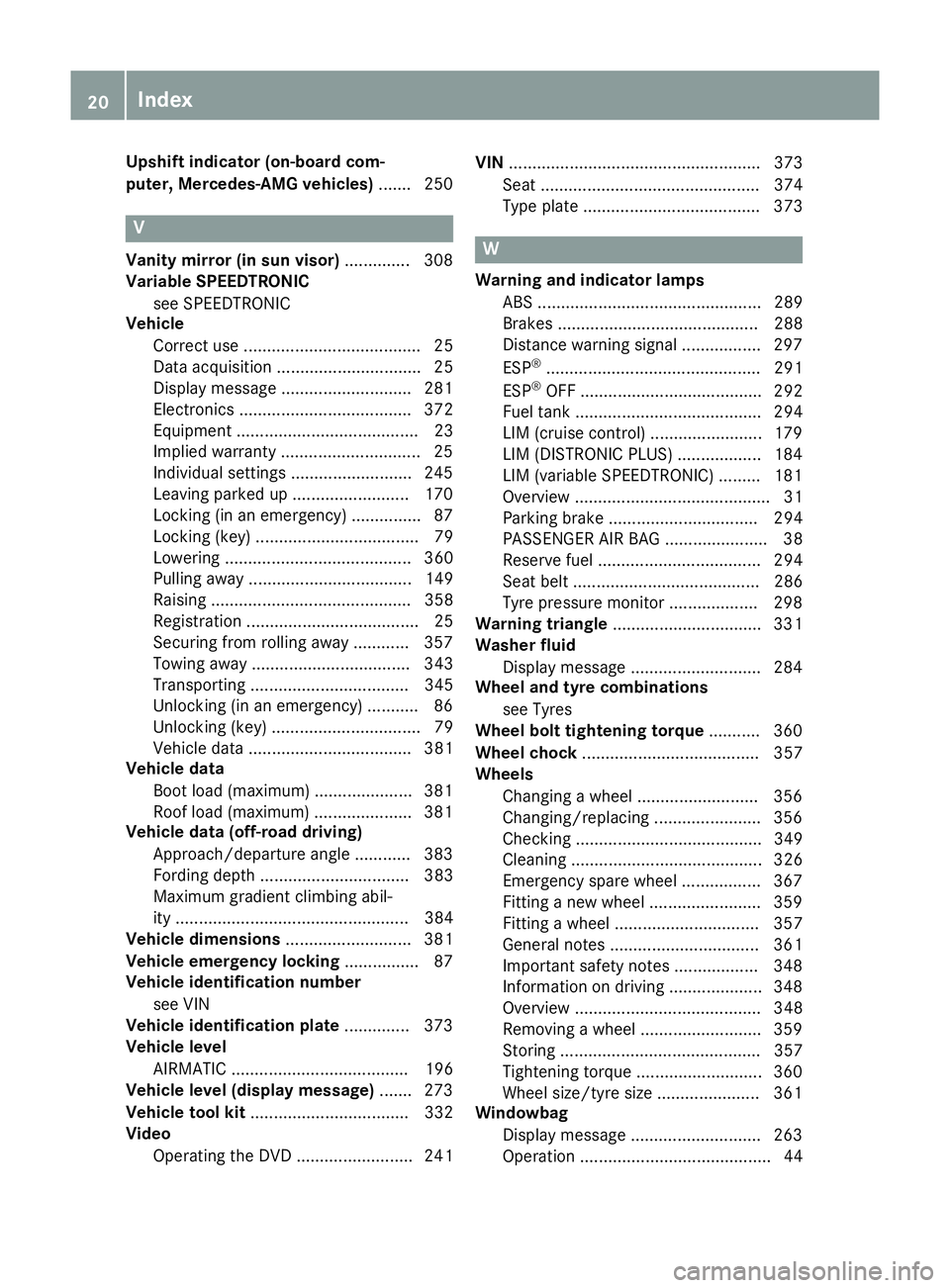
Upshift indicator (on-board com-
puter, Mercedes-AMG vehicles)
.......250 V
Vanity mirror (in sun visor) .............. 308
Variable SPEEDTRONIC
see SPEEDTRONIC
Vehicle
Correct use ...................................... 25
Data acquisition ............................... 25
Display message ............................ 281
Electronics ..................................... 372
Equipment ....................................... 23
Implied warranty .............................. 25
Individual settings .......................... 245
Leaving parked up ......................... 170
Locking (in an emergency) .............. .87
Locking (key) ................................... 79
Lowering ........................................ 360
Pulling away ................................... 149
Raising ........................................... 358
Registration ..................................... 25
Securing from rolling away ............ 357
Towing away .................................. 343
Transporting .................................. 345
Unlocking (in an emergency) ........... 86
Unlocking (key) ................................ 79
Vehicle data ................................... 381
Vehicle data
Boot load (maximum) ..................... 381
Roof load (maximum) ..................... 381
Vehicle data (off-road driving)
Approach/departure angle ............ 383
Fording depth ................................ 383
Maximum gradient climbing abil-
ity .................................................. 384
Vehicle dimensions ........................... 381
Vehicle emergency locking ................ 87
Vehicle identification number
see VIN
Vehicle identification plate .............. 373
Vehicle level
AIRMATIC ...................................... 196
Vehicle level (display message) ....... 273
Vehicle tool kit .................................. 332
Video
Operating the DVD ......................... 241 VIN
...................................................... 373
Seat ............................................... 374
Type plate ...................................... 373 W
Warning and indicator lamps ABS ................................................ 289
Brakes ........................................... 288
Distance warning signal ................. 297
ESP ®
.............................................. 291
ESP ®
OFF ....................................... 292
Fuel tank ........................................ 294
LIM (cruise control) ........................ 179
LIM (DISTRONIC PLUS) .................. 184
LIM (variable SPEEDTRONIC) ......... 181
Overview .......................................... 31
Parking brake ................................ 294
PASSENGER AIR BAG ...................... 38
Reserve fue l................................... 294
Seat belt ........................................ 286
Tyre pressure monitor ................... 298
Warning triangle ................................ 331
Washer fluid
Display message ............................ 284
Wheel and tyre combinations
see Tyres
Wheel bolt tightening torque ........... 360
Wheel chock ...................................... 357
Wheels
Changing a whee l.......................... 356
Changing/replacing ....................... 356
Checking ........................................ 349
Cleaning ......................................... 326
Emergency spare whee l................. 367
Fitting a new wheel ........................ 359
Fitting a wheel ............................... 357
General notes ................................ 361
Important safety notes .................. 348
Information on driving .................... 348
Overview ........................................ 348
Removing a whee l.......................... 359
Storing ........................................... 357
Tightening torque ........................... 360
Wheel size/tyre size ...................... 361
Windowbag
Display message ............................ 263
Operation ......................................... 44 20
Index
Page 73 of 393
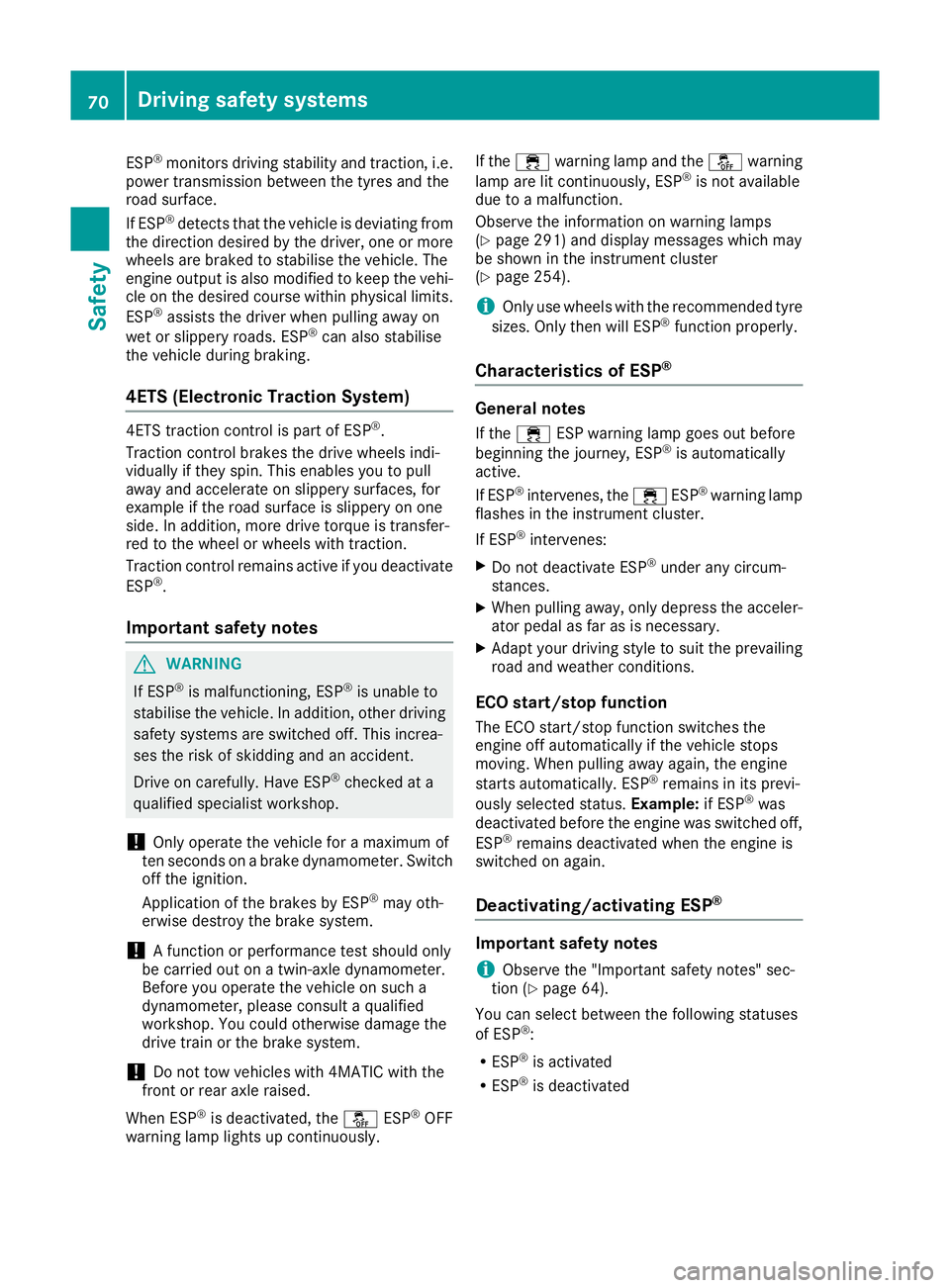
ESP
®
monitors driving stability and traction, i.e.
power transmission between the tyres and the
road surface.
If ESP ®
detects that the vehicle is deviating from
the direction desired by the driver, one or more
wheels are braked to stabilise the vehicle. The
engine output is also modified to keep the vehi- cle on the desired course within physical limits.
ESP ®
assists the driver when pulling away on
wet or slippery roads. ESP ®
can also stabilise
the vehicle during braking.
4ETS (Electronic Traction System) 4ETS traction control is part of ESP
®
.
Traction control brakes the drive wheels indi-
vidually if they spin. This enables you to pull
away and accelerate on slippery surfaces, for
example if the road surface is slippery on one
side. In addition, more drive torque is transfer-
red to the wheel or wheels with traction.
Traction control remains active if you deactivate
ESP ®
.
Important safety notes G
WARNING
If ESP ®
is malfunctioning, ESP ®
is unable to
stabilise the vehicle. In addition, other driving
safety systems are switched off. This increa-
ses the risk of skidding and an accident.
Drive on carefully. Have ESP ®
checked at a
qualified specialist workshop.
! Only operate the vehicle for a maximum of
ten seconds on a brake dynamometer. Switch off the ignition.
Application of the brakes by ESP ®
may oth-
erwise destroy the brake system.
! A function or performance test should only
be carried out on a twin-axle dynamometer.
Before you operate the vehicle on such a
dynamometer, please consult a qualified
workshop. You could otherwise damage the
drive train or the brake system.
! Do not tow vehicles with 4MATIC with the
front or rear axle raised.
When ESP ®
is deactivated, the åESP®
OFF
warning lamp lights up continuously. If the
÷ warning lamp and the åwarning
lamp are lit continuously, ESP ®
is not available
due to a malfunction.
Observe the information on warning lamps
(Y page 291) and display messages which may
be shown in the instrument cluster
(Y page 254).
i Only use wheels with the recommended tyre
sizes. Only then will ESP ®
function properly.
Characteristics of ESP ® General notes
If the ÷ ESP warning lamp goes out before
beginning the journey, ESP ®
is automatically
active.
If ESP ®
intervenes, the ÷ESP®
warning lamp
flashes in the instrument cluster.
If ESP ®
intervenes:
X Do not deactivate ESP ®
under any circum-
stances.
X When pulling away, only depress the acceler-
ator pedal as far as is necessary.
X Adapt your driving style to suit the prevailing
road and weather conditions.
ECO start/stop function
The ECO start/stop function switches the
engine off automatically if the vehicle stops
moving. When pulling away again, the engine
starts automatically. ESP ®
remains in its previ-
ously selected status. Example:if ESP®
was
deactivated before the engine was switched off,
ESP ®
remains deactivated when the engine is
switched on again.
Deactivating/activating ESP ® Important safety notes
i Observe the "Important safety notes" sec-
tion (Y page 64).
You can select between the following statuses
of ESP ®
:
R ESP ®
is activated
R ESP ®
is deactivated 70
Driving safety systemsSafety
Page 74 of 393
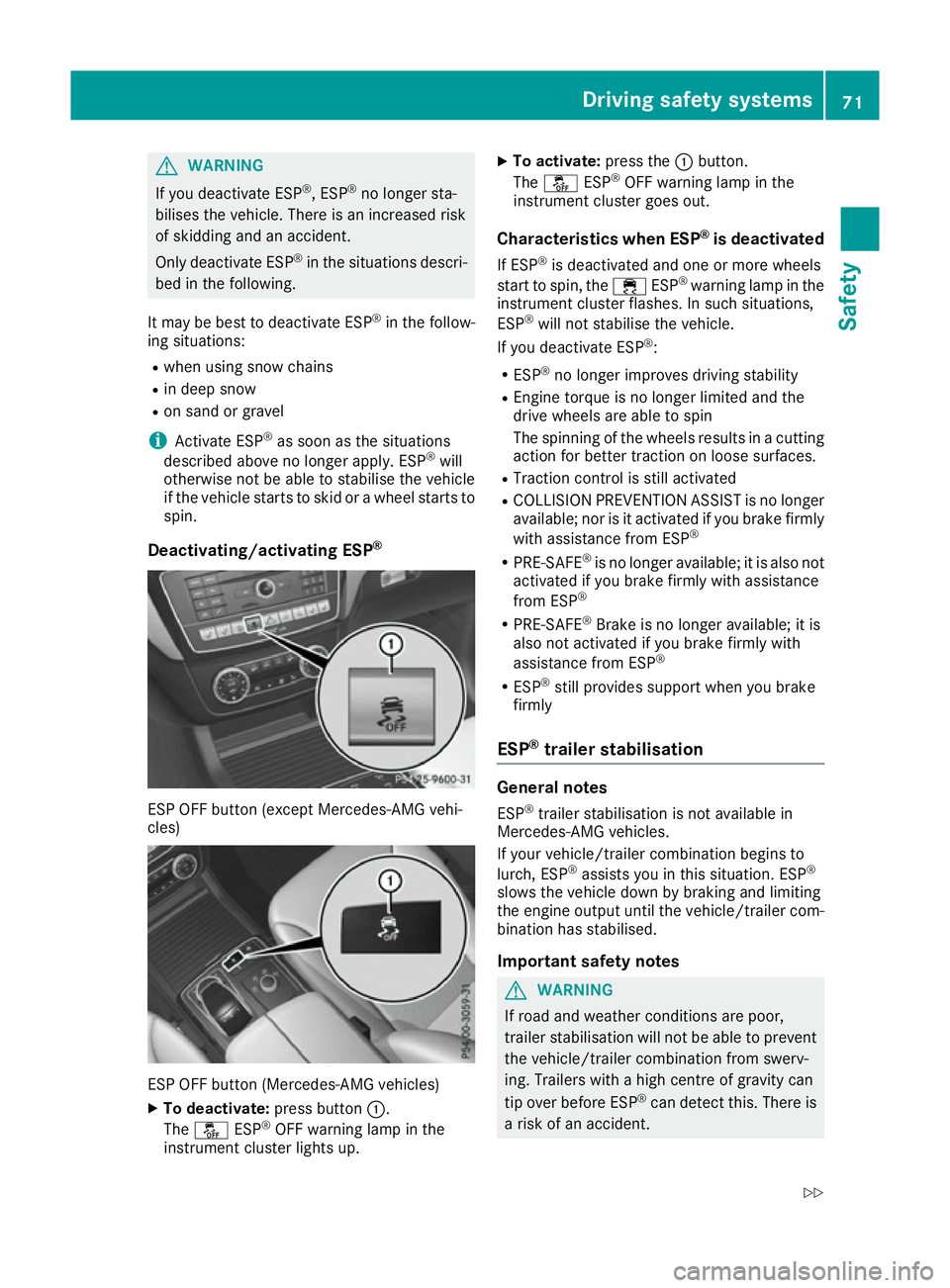
G
WARNING
If you deactivate ESP ®
, ESP ®
no longer sta-
bilises the vehicle. There is an increased risk
of skidding and an accident.
Only deactivate ESP ®
in the situations descri-
bed in the following.
It may be best to deactivate ESP ®
in the follow-
ing situations:
R when using snow chains
R in deep snow
R on sand or gravel
i Activate ESP ®
as soon as the situations
described above no longer apply. ESP ®
will
otherwise not be able to stabilise the vehicle
if the vehicle starts to skid or a wheel starts to
spin.
Deactivating/activating ESP ®ESP OFF button (except Mercedes-AMG vehi-
cles)
ESP OFF button (Mercedes-AMG vehicles)
X To deactivate: press button:.
The å ESP®
OFF warning lamp in the
instrument cluster lights up. X
To activate: press the:button.
The å ESP®
OFF warning lamp in the
instrument cluster goes out.
Characteristics when ESP ®
is deactivated
If ESP ®
is deactivated and one or more wheels
start to spin, the ÷ESP®
warning lamp in the
instrument cluster flashes. In such situations,
ESP ®
will not stabilise the vehicle.
If you deactivate ESP ®
:
R ESP ®
no longer improves driving stability
R Engine torque is no longer limited and the
drive wheels are able to spin
The spinning of the wheels results in a cutting
action for better traction on loose surfaces.
R Traction control is still activated
R COLLISION PREVENTION ASSIST is no longer
available; nor is it activated if you brake firmly
with assistance from ESP ®
R PRE-SAFE ®
is no longer available; it is also not
activated if you brake firmly with assistance
from ESP ®
R PRE-SAFE ®
Brake is no longer available; it is
also not activated if you brake firmly with
assistance from ESP ®
R ESP ®
still provides support when you brake
firmly
ESP ®
trailer stabilisation General notes
ESP ®
trailer stabilisation is not available in
Mercedes-AMG vehicles.
If your vehicle/trailer combination begins to
lurch, ESP ®
assists you in this situation. ESP ®
slows the vehicle down by braking and limiting
the engine output until the vehicle/trailer com-
bination has stabilised.
Important safety notes G
WARNING
If road and weather conditions are poor,
trailer stabilisation will not be able to prevent the vehicle/trailer combination from swerv-
ing. Trailers with a high centre of gravity can
tip over before ESP ®
can detect this. There is
a risk of an accident. Driving safety systems
71Safety
Z
Page 363 of 393
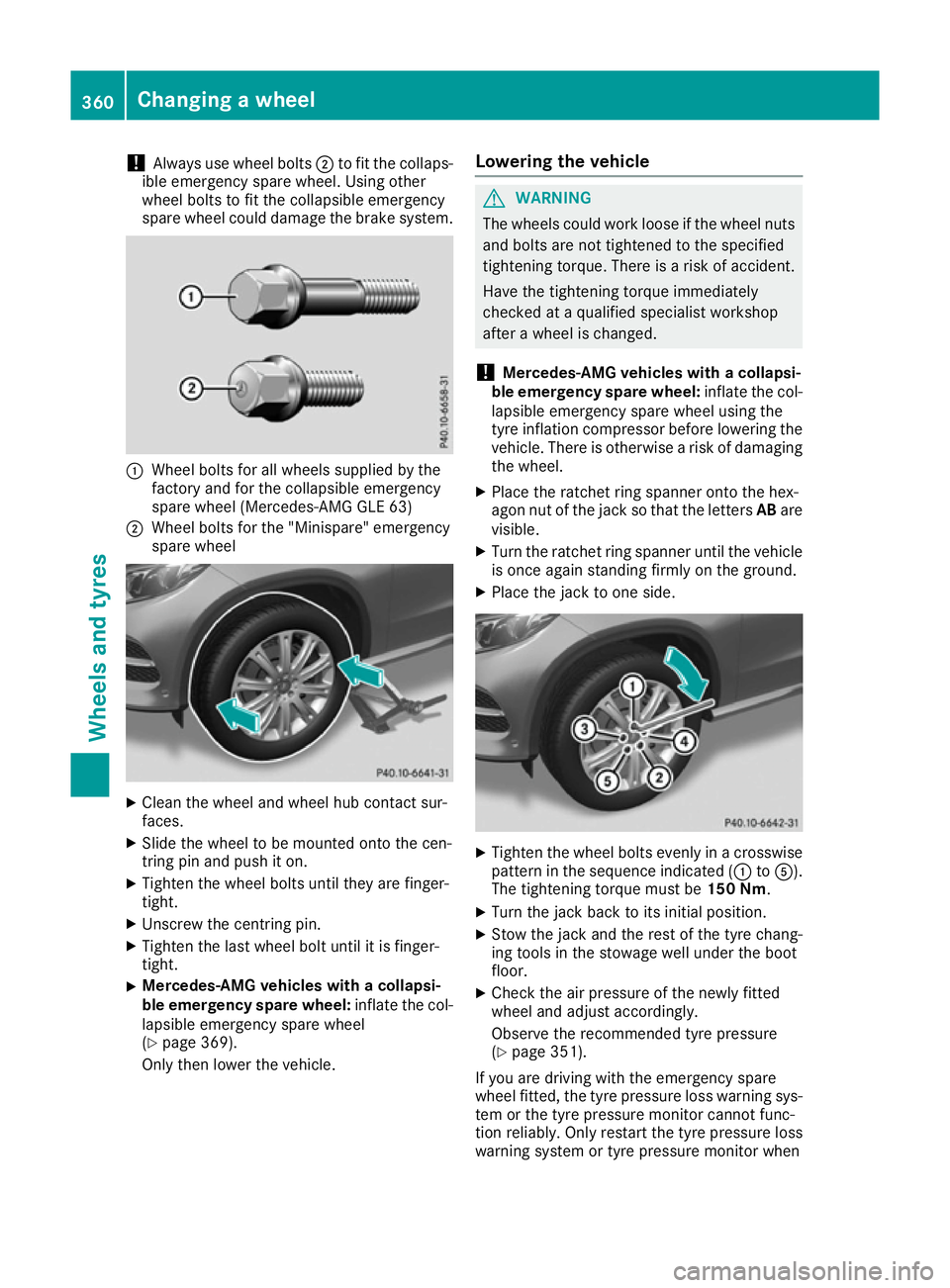
!
Always use wheel bolts
;to fit the collaps-
ible emergency spare wheel. Using other
wheel bolts to fit the collapsible emergency
spare wheel could damage the brake system. :
Wheel bolts for all wheels supplied by the
factory and for the collapsible emergency
spare wheel (Mercedes-AMG GLE 63)
; Wheel bolts for the "Minispare" emergency
spare wheel X
Clean the wheel and wheel hub contact sur-
faces.
X Slide the wheel to be mounted onto the cen-
tring pin and push it on.
X Tighten the wheel bolts until they are finger-
tight.
X Unscrew the centring pin.
X Tighten the last wheel bolt until it is finger-
tight.
X Mercedes-AMG vehicles with a collapsi-
ble emergency spare wheel:
inflate the col-
lapsible emergency spare wheel
(Y page 369).
Only then lower the vehicle. Lowering the vehicle G
WARNING
The wheels could work loose if the wheel nuts and bolts are not tightened to the specified
tightening torque. There is a risk of accident.
Have the tightening torque immediately
checked at a qualified specialist workshop
after a wheel is changed.
! Mercedes-AMG vehicles with a collapsi-
ble emergency spare wheel: inflate the col-
lapsible emergency spare wheel using the
tyre inflation compressor before lowering the vehicle. There is otherwise a risk of damaging
the wheel.
X Place the ratchet ring spanner onto the hex-
agon nut of the jack so that the letters ABare
visible.
X Turn the ratchet ring spanner until the vehicle
is once again standing firmly on the ground.
X Place the jack to one side. X
Tighten the wheel bolts evenly in a crosswise
pattern in the sequence indicated (: toA).
The tightening torque must be 150 Nm.
X Turn the jack back to its initial position.
X Stow the jack and the rest of the tyre chang-
ing tools in the stowage well under the boot
floor.
X Check the air pressure of the newly fitted
wheel and adjust accordingly.
Observe the recommended tyre pressure
(Y page 351).
If you are driving with the emergency spare
wheel fitted, the tyre pressure loss warning sys-
tem or the tyre pressure monitor cannot func-
tion reliably. Only restart the tyre pressure loss
warning system or tyre pressure monitor when 360
Changing a wheelWheels and tyres
Page 387 of 393
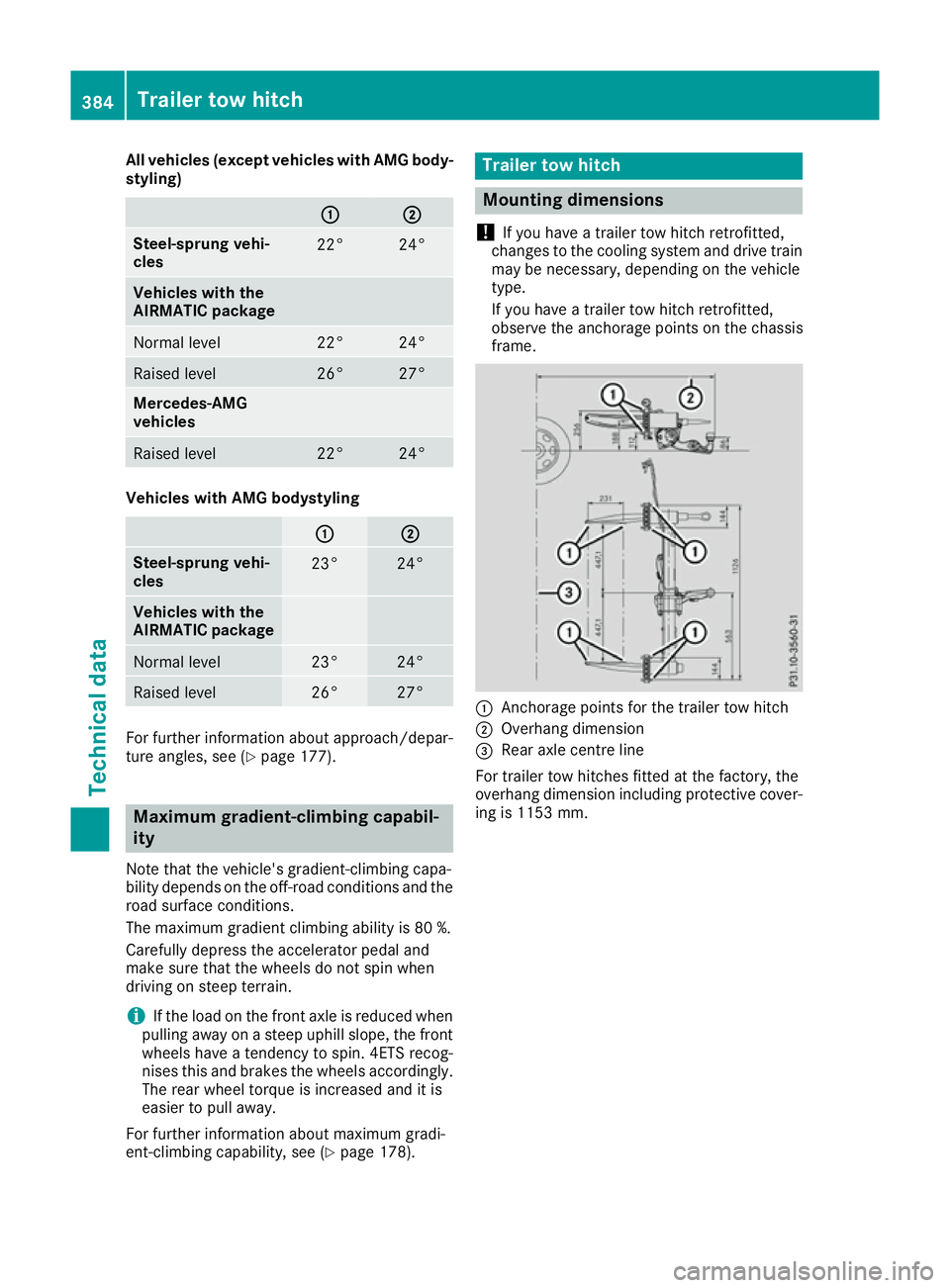
All vehicles (except vehicles with AMG body-
styling) :
: ;
;
Steel-sprung vehi-
cles
22° 24°
Vehicles with the
AIRMATIC package Normal level 22° 24°
Raised level 26° 27°
Mercedes-AMG
vehicles
Raised level 22° 24°
Vehicles with AMG bodystyling
: : ;
;
Steel-sprung vehi-
cles
23° 24°
Vehicles with the
AIRMATIC package
Normal level 23° 24°
Raised level 26° 27°
For further information about approach/depar-
ture angles, see (Y
page 177).Maximum gradient-climbing capabil-
ity
Note that the vehicle's gradient-climbing capa-
bility depends on the off-road conditions and the road surface conditions.
The maximum gradient climbing ability is 80 %.
Carefully depress the accelerator pedal and
make sure that the wheels do not spin when
driving on steep terrain.
i If the load on the front axle is reduced when
pulling away on a steep uphill slope, the front
wheels have a tendency to spin. 4ETS recog-
nises this and brakes the wheels accordingly. The rear wheel torque is increased and it is
easier to pull away.
For further information about maximum gradi-
ent-climbing capability, see (Y page 178). Trailer tow hitch
Mounting dimensions
! If you have a trailer tow hitch retrofitted,
changes to the cooling system and drive train
may be necessary, depending on the vehicle
type.
If you have a trailer tow hitch retrofitted,
observe the anchorage points on the chassis
frame. :
Anchorage points for the trailer tow hitch
; Overhang dimension
= Rear axle centre line
For trailer tow hitches fitted at the factory, the
overhang dimension including protective cover- ing is 1153 mm. 384
Trailer tow hitchTechnical data